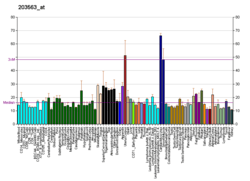AFAP1
| AFAP1 | |||||||||||||||||
|---|---|---|---|---|---|---|---|---|---|---|---|---|---|---|---|---|---|
| Identifiers | |||||||||||||||||
| Aliases | AFAP1, AFAP, AFAP-110, AFAP110, actin filament associated protein 1 | ||||||||||||||||
| External IDs | MGI: 1917542 HomoloGene: 11009 GeneCards: AFAP1 | ||||||||||||||||
| |||||||||||||||||
| RNA expression pattern | |||||||||||||||||
 | |||||||||||||||||
| More reference expression data | |||||||||||||||||
| Orthologs | |||||||||||||||||
| Species | Human | Mouse | |||||||||||||||
| Entrez | |||||||||||||||||
| Ensembl | |||||||||||||||||
| UniProt | |||||||||||||||||
| RefSeq (mRNA) | |||||||||||||||||
| RefSeq (protein) | |||||||||||||||||
| Location (UCSC) | Chr 4: 7.76 – 7.94 Mb | Chr 5: 35.89 – 36 Mb | |||||||||||||||
| PubMed search | [1] | [2] | |||||||||||||||
| Wikidata | |||||||||||||||||
| |||||||||||||||||
Actin filament-associated protein 1 is a protein that in humans is encoded by the AFAP1 gene.[3][4][5][6]
The protein encoded by this gene is a Src binding partner. It may represent a potential modulator of actin filament integrity in response to cellular signals, and may function as an adaptor protein by linking Src family members and/or other signaling proteins to actin filaments. Two alternative transcripts encoding the same protein have been identified.[6]
References
- ↑ "Human PubMed Reference:".
- ↑ "Mouse PubMed Reference:".
- ↑ Qian Y, Gatesman AS, Baisden JM, Zot HG, Cherezova L, Qazi I, Mazloum N, Lee MY, Guappone-Koay A, Flynn DC (Feb 2004). "Analysis of the role of the leucine zipper motif in regulating the ability of AFAP-110 to alter actin filament integrity". J Cell Biochem. 91 (3): 602–20. PMID 14755689. doi:10.1002/jcb.10725.
- ↑ Baisden JM, Gatesman AS, Cherezova L, Jiang BH, Flynn DC (Oct 2001). "The intrinsic ability of AFAP-110 to alter actin filament integrity is linked with its ability to also activate cellular tyrosine kinases". Oncogene. 20 (45): 6607–16. PMID 11641786. doi:10.1038/sj.onc.1204802.
- ↑ Baisden JM, Qian Y, Zot HM, Flynn DC (Oct 2001). "The actin filament-associated protein AFAP-110 is an adaptor protein that modulates changes in actin filament integrity". Oncogene. 20 (44): 6435–47. PMID 11607843. doi:10.1038/sj.onc.1204784.
- 1 2 "Entrez Gene: AFAP1 actin filament associated protein 1".
External links
- Human AFAP1 genome location and AFAP1 gene details page in the UCSC Genome Browser.
Further reading
- Ishida Y, Hadano S, Nagayama T, et al. (1995). "Isolation and characterization of 21 novel expressed DNA sequences from the distal region of human chromosome 4p.". Genomics. 22 (2): 302–12. PMID 7545969. doi:10.1006/geno.1994.1388.
- Qian Y, Baisden JM, Westin EH, et al. (1998). "Src can regulate carboxy terminal interactions with AFAP-110, which influence self-association, cell localization and actin filament integrity.". Oncogene. 16 (17): 2185–95. PMID 9619827. doi:10.1038/sj.onc.1201753.
- Guappone AC, Weimer T, Flynn DC (1998). "Formation of a stable src-AFAP-110 complex through either an amino-terminal or a carboxy-terminal SH2-binding motif.". Mol. Carcinog. 22 (2): 110–9. PMID 9655255. doi:10.1002/(SICI)1098-2744(199806)22:2<110::AID-MC6>3.0.CO;2-Q.
- Qian Y, Baisden JM, Zot HG, et al. (2000). "The carboxy terminus of AFAP-110 modulates direct interactions with actin filaments and regulates its ability to alter actin filament integrity and induce lamellipodia formation.". Exp. Cell Res. 255 (1): 102–13. PMID 10666339. doi:10.1006/excr.1999.4795.
- Qian Y, Baisden JM, Cherezova L, et al. (2003). "PC phosphorylation increases the ability of AFAP-110 to cross-link actin filaments.". Mol. Biol. Cell. 13 (7): 2311–22. PMC 117315
 . PMID 12134071. doi:10.1091/mbc.E01-12-0148.
. PMID 12134071. doi:10.1091/mbc.E01-12-0148. - Strausberg RL, Feingold EA, Grouse LH, et al. (2003). "Generation and initial analysis of more than 15,000 full-length human and mouse cDNA sequences.". Proc. Natl. Acad. Sci. U.S.A. 99 (26): 16899–903. PMC 139241
 . PMID 12477932. doi:10.1073/pnas.242603899.
. PMID 12477932. doi:10.1073/pnas.242603899. - Brandenberger R, Wei H, Zhang S, et al. (2005). "Transcriptome characterization elucidates signaling networks that control human ES cell growth and differentiation.". Nat. Biotechnol. 22 (6): 707–16. PMID 15146197. doi:10.1038/nbt971.
- Ballif BA, Villén J, Beausoleil SA, et al. (2005). "Phosphoproteomic analysis of the developing mouse brain.". Mol. Cell Proteomics. 3 (11): 1093–101. PMID 15345747. doi:10.1074/mcp.M400085-MCP200.
- Rual JF, Venkatesan K, Hao T, et al. (2005). "Towards a proteome-scale map of the human protein-protein interaction network.". Nature. 437 (7062): 1173–8. PMID 16189514. doi:10.1038/nature04209.
- Kimura K, Wakamatsu A, Suzuki Y, et al. (2006). "Diversification of transcriptional modulation: large-scale identification and characterization of putative alternative promoters of human genes.". Genome Res. 16 (1): 55–65. PMC 1356129
 . PMID 16344560. doi:10.1101/gr.4039406.
. PMID 16344560. doi:10.1101/gr.4039406. - Dorfleutner A, Stehlik C, Zhang J, et al. (2007). "AFAP-110 is required for actin stress fiber formation and cell adhesion in MDA-MB-231 breast cancer cells.". J. Cell. Physiol. 213 (3): 740–9. PMID 17520695. doi:10.1002/jcp.21143.
This article is issued from
Wikipedia.
The text is licensed under Creative Commons - Attribution - Sharealike.
Additional terms may apply for the media files.